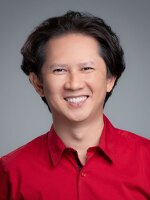Gov. Gavin Newsom concluded his five-day tour of the state Monday in Imperial Valley, getting an update on the progress of lithium production there.
Newsom is using the tour to replace his usual State of the State address and to highlight major policy goals.
The sunbaked valley has one of the world's largest lithium deposits, leading to the moniker "Lithium Valley." The California Energy Commission estimates there’s enough lithium in the Imperial Valley to meet all of the United States' projected demand and 40% of the world’s demand.
Lithium is an essential battery component as the state looks to transition toward electric vehicles by 2035.
“We had a crazy idea, signing an executive order to become the first jurisdiction in the country — only jurisdiction in the world — to require all vehicles sold in this — again, remarkable place we call home — to be alternative fuel. I could not even imagine," Newsom said. "Four or five years later, not only do we codify those goals, but you've now seen those goals advance.”
Newsom and others said lithium is part of the transformational green energy that will bring jobs to the region, which is one of the most impoverished areas in the state.
"We're reaching toward a clean energy future for the Salton Sea in our communities, a future with good paying union jobs filled by local workers," said Rep. Raul Ruiz, D-Imperial County. "A future with lower energy costs for families here in Southern California and all across the nation, and a future where the Lithium Valley is the nation's manufacturing center of clean energy batteries."
And it's not just jobs. San Diego State University (SDSU) president Adela de la Torre said the state's investment in Lithium Valley will also bring a highly educated workforce to the region. Last year, Newsom allocated $80 million in state funding for a STEM building on SDSU Imperial Valley’s Brawley campus.
"This is important because we need to produce jobs for people who are here, and we have to create wealth that stays here," she said. "And without higher education in the partnership with SDSU, that will not be possible."
Newsom's visit to Imperial County came after a stop in San Diego on Sunday, where the governor announced a proposal to fund a major expansion of housing and treatment for people with mental illness and addiction.
He said the plan is very much needed as encampments have popped up on sidewalks and under freeway overpasses throughout the state, where people experiencing mental health crises are a common sight.
“We’re fooling ourselves if we don’t address that fundamental need that we can turn this thing around,” he said at a news conference Sunday.
Linda Mimms, a mental health advocate, said it's a step in the right direction but worried that it won't address all the systemic failures in California's mental health services.
“I like that these topics are being talked about. And I think that the Mental Health Services Act, which is now 20 years old, needs a rehaul,” she said.
That is what the governor plans to do. California state Senator Susan Eggman, D-San Joaquin County, plans to introduce the ballot measure, which will also improve oversight for counties.
Mimms said that’s important because some of the funds raised under the act were misdirected.
“I want to see how they're going to do that, because that was supposed to happen with the original Mental Health Services Act," she said. "And I'm not saying all of the funds were misdirected, but many of them were.”
She would also like to see the 1967 Lanterman-Petris-Short Act reformed as well. The act authorizes involuntary psychiatric treatment in very limited circumstances. Mimms said that has resulted in individuals refusing retreatment while under psychosis and becoming homeless.
That was what happened to Anita Fisher's son. She's the director of education for the National Alliance for Mental Illness, San Diego chapter.
"Because of the gaps and holes in the system, he ended up homeless on the streets," she said at Sunday's news conference. "He ended up in jail. He ended up in prison. And I would ask myself why.”
As part of this measure, money would also be set aside to house more than 10,000 homeless veterans. The measure would go before voters on the 2024 ballot.









